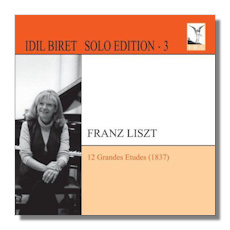
The Internet's Premier Classical Music Source
Related Links
- Liszt Reviews
- Latest Reviews
- More Reviews
-
By Composer
-
Collections
DVD & Blu-ray
Books
Concert Reviews
Articles/Interviews
Software
Audio
Search Amazon
Recommended Links
Site News
 CD Review
CD Review
Franz Liszt

Idil Biret Solo Edition, Volume 3
12 Grandes Etudes (1837)
- Etude #1 in C Major: Presto
- Etude #2 in A minor: Molto vivace
- Etude #3 in F Major: Poco adagio
- Etude #4 in D minor: Allegro patetico
- Etude #5 in B Flat Major: Egualmente
- Etude #6 in G minor: Largo patetico
- Etude #7 in E Flat Major: Allegro deciso
- Etude #8 in C minor: Presto strepitoso
- Etude #9 in A Flat Major: Andantino
- Etude #10 in F minor: Presto molto agitato
- Etude #11 in D Flat Major: Lento assai
- Etude #12 in B Flat minor: Andantino
Idil Biret, piano
Naxos 8.571287 79:33
The 12 Grandes Etudes of 1837 are really the second of three versions of a set of pieces that began in 1826 as Etude en douze exercises (Study in twelve exercises), when Liszt was only fourteen. The final version, the Transcendental Etudes, appeared in 1851, and it is this final set that is by far the best known of the three. It should be noted that Liszt supplied subtitles to the 1851 set, except for Nos. 2 and 10.
The 1837 version played by Idil Biret here is known for its less refined and somewhat more daring writing. It is also, as many may be aware, known for its great level of difficulty. Most of the pieces are exceedingly challenging: try Nos. 5 and 8, to cite just two examples from the set, to hear astoundingly demanding keyboard writing. But I suspect that relatively few listeners will be impressed by that aspect of the music alone, as most are interested in the artistic worth of the pieces. While the 1837 version is certainly better than the original, it often sounds like a collection of early drafts of the 1851 version – but very interesting early drafts. Pieces like #11 can stand comparison with their counterparts in the 1851 set, but most seem tinged with a youthful and sometimes over-the-top spirit, offering a mixture of the virtuosic and the daring, and the glittery and the gritty. Yet, rarely is there a moment when the less mature character of the set disappoints.
True, Liszt pruned some music from 1837 (the third theme from #8, a fast episode building toward the climax of #11, etc.), but his changes, while masterly and well considered, also stripped away some of the youthful daring and bold character that infused the music with its own distinctive persona. I should note that overall the cuts reduced the length of some pieces by nearly half, as with #8, which clocks in here at 9:14, while #8 (Wilde Jagd) in the 1851 set lasts about 5:00.
Idil Biret, who recorded the works in April, 2011, turns in consistently fine performances. Actually, she approaches the music with a mature manner that some might think is more appropriate for the 1851 set. Yet, she's able to find much depth in the music without slighting the pyrotechnics (try the darkly colored #6 or the virtuosic but substantive #8 or, best of all, her splendidly lyrical #11). Actually, all her performances are consistently engaging, and Naxos provides her with excellent sound reproduction.
There's little competition on record in this 1837 set. Leslie Howard recorded it for Hyperion and Janice Weber for IMP Masters, the latter billed as the "1838 Transcendental Etudes" (also on MCA MCAD-25890). I am not familiar with either of these recordings, though I would expect that Howard's are well played, and if I recall correctly, Weber's received generally positive notices. As for Biret, I can only observe that her sensitivity and assured technique in these pieces make the recording a quite appealing offering. Liszt mavens will certainly regard this as a major recording event, and for those interested in 19th century keyboard music this will have strong appeal.
Copyright © 2012, Robert Cummings





















